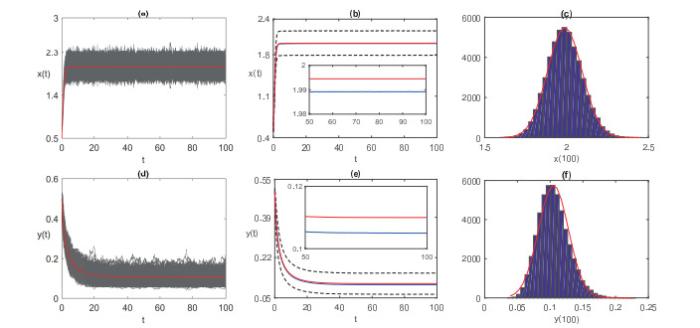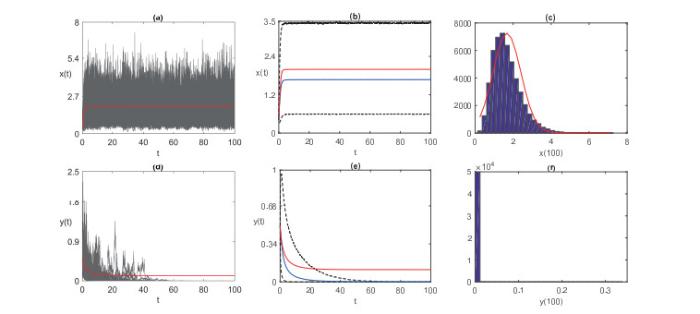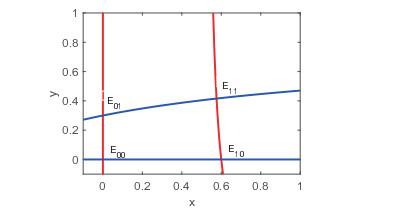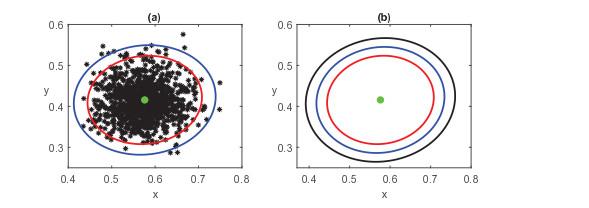1 引言
功能反应在捕食者-食饵系统[9-18] 和流行病系统[19-21] 的研究中起着非常重要的作用. 它表示捕食者在单位时间内杀死食饵的数量, 描述了不同营养水平之间的生物转移量. 1975年, Crowley和Martin[22]提出了Crowley-Martin型功能反应函数
其中,
表 1 系统(1.1)中参数的生物意义
| 符号 | 生物学意义 |
| 在没有捕食的情况下, 食饵种群的内在增长率 | |
| 攻击系数 | |
| 处理时间 | |
| 捕食者个体之间的干扰程度 | |
| 在没有捕食的情况下, 捕食者种群的内在增长率 | |
| 捕食的转化率 | |
| 布朗运动 |
注意到, 对于系统(1.1)吕等[29]给出了两个种群的持久性. 特别地, 他们指出该系统存在一个遍历的平稳分布. 然而, 有两个关键问题被忽视了: (ⅰ) 捕食者灭绝的条件是什么? 当捕食者的数量趋于灭绝时, 食饵的数量如何变化? (ⅱ) 捕食者-食饵系统的动力学能像确定性系统那样通过阈值来区分吗?
该文旨在改进和优化吕等[29]的结果, 提出了一个阈值参数来研究随机系统(1.1) 的动力学. 结果表明: (ⅰ) 当
2 长期的随机动力学
引理2.1[34] 考虑以下一维模型
(ⅰ) 当
(ⅱ) 当
为了研究随机系统(1.1)的动力学, 定义
令
定理2.2 假设
(ⅰ) 当
(ⅱ) 当
证 (Ⅰ) 情形
由此可见
因为
则有
根据随机比较定理有
令
对
选择
假设
根据Portmanteau定理,
因为
由此可见
根据(2.7), (2.9)和(2.10)式得
因为
(Ⅱ) 情形
其中
对方程(2.11)关于
因为
和
可以推导得
剩下的证明类似于文献[34]中定理2.2的标准论证.
注2.3(生物学意义) (ⅰ) 李雅普诺夫指数
接下来, 给出两个例子来验证定理2.1的结果, 并说明随机噪声对捕食者-食饵种群相互作用的影响. 针对随机模型(1.1)和相应的确定型模型(即
例2.4 首先, 研究较小强度的噪声对随机系统(1.1)的动力学影响. 令
图 1
图 1
较小强度噪声对随机模型(1.1)的动力学影响, 其中图中红色实线表示相应确定性模型(1.1)的解. (a) 灰色实线为随机模型(1.1)解
例2.5 现在, 研究较大强度的噪声对随机系统(1.1)的动力学影响. 令
图 2
图 2
较大强度噪声对随机模型(1.1)的动力学影响, 其中图中红色实线表示相应确定性模型(1.1)的解. (a) 灰色实线为随机模型(1.1)解
我们总结例2.4和例2.5的生物学意义如下.
2) 大的噪声导致种群灭绝. 由图 2可以看出, 确定性模型的解是持久的, 而当噪声强度较大时, 随机模型的解
3 随机敏感性分析
接下来, 参考吕等在文献[29]中的参数, 即
定理3.1 (平衡点的存在性和稳定性) 根据上述参数, 确定性模型(3.1)有三个边界平衡点和一个内部平衡点, 即
(1) 确定型模型(3.1)在点
(2) 确定性模型(3.1)在点
(3) 确定性模型(3.1)在点
(4) 确定性模型(3.1)在点
证 确定性模型(3.1)的平衡点应满足以下条件
通过解方程(3.2), 可知确定性模型(3.1)有三个边界平衡点
图 3
图 3
确定性模型(3.1)平衡点的存在性, 参数:
下面分析确定性模型(3.1)平衡点的稳定性. 为了方便研究, 设为模型(3.1)对应的平衡点为
因此, 确定性模型(3.1)在
现在使用文献[35]中的方法对随机模型(1.1)进行随机敏感性分析, 该方法由与噪声强度
式中,
强制系统(3.3)的随机轨迹离开了一个确定性吸引子, 并形成一个相应的具有平稳概率分布
为了近似
其中,
该矩阵描述了随机系统(3.3)在确定性平衡点
式中,
现在得到了置信椭圆方程的标准形式, 为了简单起见, 令
定理3.2 根据上述参数, 随机模型(1.1)的置信椭圆方程为
其中
证 定义
式中, 雅可比矩阵
通过解方程(3.9), 可得随机敏感性矩阵在
则置信概率为
定理3.2证明完毕.
接下来, 给出一个例子来说明上面的结果.
例3.3 使用参数
图 4
图 4
平衡点和置信椭圆. (a) 1000个随机变量在时间
(1) 在没有噪声的情况下, 置信椭圆变为一个点, 即确定性模型(3.1)的稳定内部平衡点
(2) 随着置信概率的增加(从95%增加到99%), 置信椭圆中包含的样本也越来越多. 这说明在实际应用中, 要使统计结果更加准确, 应选择合理的置信概率.
4 结论
文章研究了一类具有Crowley-Martin型函数响应的随机捕食者-食饵模型. 结果表明, 捕食者-食饵模型的随机动力学可以通过一个关键参数
此外, 提出了随机敏感性分析方法来观察噪声对随机捕食者-食饵系统动力学的影响. 研究结果表明, 较小强度的噪声可以抑制种群规模的扩大, 而较大强度的噪声则会导致种群的灭绝. 与此同时, 通过Matlab数值模拟得到如下结果: 在没有噪声的情况下, 置信椭圆变成为一个点, 这是确定性模型(3.1)的稳定的内部平衡点
参考文献
Ecoepidemic predator-prey model with feeding satiation, prey herd behavior and abandoned infected prey
DOI:10.1016/j.mbs.2016.02.003 [本文引用: 1]
Traveling waves for a generalized Holling-Tanner predator-prey model
Dynamics of a diffusion reaction prey-predator model with delay in prey: Effects of delay and spatial components
DOI:10.1016/j.jmaa.2018.01.046
A two-patch prey-predator model with predator dispersal driven by the predation strength
Refuge-mediated predator-prey dynamics and biomass pyramids
Dynamical analysis of a stage-structured predator-prey model with cannibalism
一类带治疗项的非局部扩散SIR传染病模型的行波解
DOI:10.3969/j.issn.1003-3998.2020.01.008
Traveling wave solutions of a nonlocal spreading SIR infectious disease model with treatment term
DOI:10.3969/j.issn.1003-3998.2020.01.008
一类具有随机扰动的非自治SIRI流行病模型的动力学行为
DOI:10.3969/j.issn.1003-3998.2020.01.017 [本文引用: 1]
Dynamic behavior of a nonautonomous SIRI epidemic model with random perturbations
DOI:10.3969/j.issn.1003-3998.2020.01.017 [本文引用: 1]
Dynamic threshold probe of stochastic SIR model with saturated incidence rate and saturated treatment function
DOI:10.1016/j.physa.2019.122300 [本文引用: 1]
Progressive dynamics of a stochastic epidemic model with logistic growth and saturated treatment
DOI:10.1016/j.physa.2019.122649
Analysis of SIR epidemic models with nonlinear incidence rate and treatment
Global dynamics of an infinite dimensional epidemic model with nonlocal state structures
Qualitative analysis of stochastically perturbed SIRS epidemic model with two viruses
A stochastic SIRS epidemic model with infectious force under intervention strategies
Stationary distribution of a stochastic delayed SVEIR epidemic model with vaccination and saturation incidence
DOI:10.1016/j.physa.2018.08.054
Ergodic stationary distribution and extinction of a stochastic SIRS epidemic model with logistic growth and nonlinear incidence
The threshold of a deterministic and a stochastic SIQS epidemic model with varying total population size
一类带有交叉扩散的捕食-食饵模型的正解
DOI:10.3969/j.issn.1003-3998.2019.03.014 [本文引用: 1]
Positive solution of a predator-prey model with cross diffusion
DOI:10.3969/j.issn.1003-3998.2019.03.014 [本文引用: 1]
Persistence and extinction of a modified Leslie-Gower Holling-type Ⅱ stochastic predator-prey model with impulsive toxicant input in polluted environments
DOI:10.1016/j.nahs.2017.08.001 [本文引用: 1]
Stability for a new discrete ratio-dependent predator-prey system
具周期性潜伏期的SEIR传染病模型的动力学
DOI:10.3969/j.issn.1003-3998.2020.02.023 [本文引用: 1]
Dynamics of a SEIR infectious disease model with periodic incubation periods
DOI:10.3969/j.issn.1003-3998.2020.02.023 [本文引用: 1]
Functional responses and interference within and between year classes of a dragony population
Periodic behavior in a FIV model with seasonality as well as environment fluctuations
DOI:10.1016/j.jfranklin.2017.08.034 [本文引用: 1]
Global existence of solutions and uniform persistence of a diffusive predator-prey model with prey-taxis
Dynamics of stage-structure predator-prey systems under density-dependent effect and mortality
DOI:10.1016/j.ecocom.2020.100812
Global analysis of a stochastic TB model with vaccination and treatment
Average break-even concentration in a simple chemostat model with telegraph noise
DOI:10.1016/j.nahs.2018.03.007
Stationary distribution and persistence of a stochastic predator-prey model with a functional response
Analysis of excitability for the FitzHugh-Nagumo model via a stochastic sensitivity function technique
DOI:10.1103/PhysRevE.83.061109 [本文引用: 2]
Analysis of nonlinear stochastic oscillations in the biochemical Goldbeter model
DOI:10.1016/j.cnsns.2019.02.008
Stochastic sensitivity and variability of glycolytic oscillations in the randomly forced Sel'kov model
Analysis of noise-induced phenomena in the nonlinear tumor-immune system
Conditions for permanence and ergodicity of certain stochastic predator-prey models
Confidence domains in the analysis of noise-induced transition to chaos for Goodwin model of business cycles
Sensitivity and chaos control for the forced nonlinear oscillations
The asymptotic behavior of a stochastic Predator-Prey system with Holling Ⅱ functional response
Dynamics of a stochastic predator-prey system with Beddington-DeAngelis functional response
On the dynamics of Predator-Prey models with the Beddington-DeAngelis functional response
Stochastic hepatitis C virus system with host immunity






